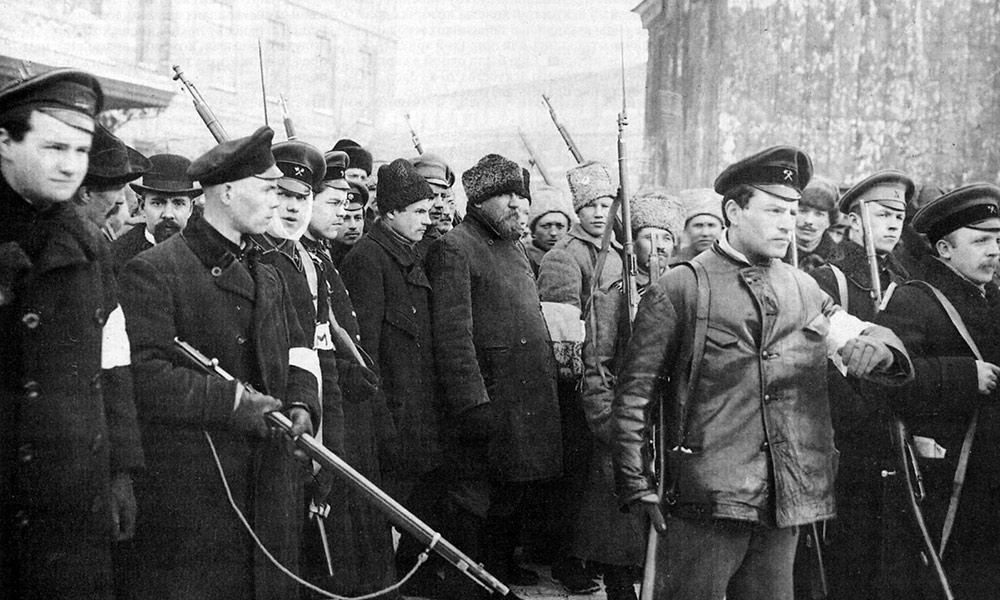By Matt Lenoe, Associate Professor of History and Chair, Department of History
Exactly 100 years ago this month, as the Russian Empire collapsed following defeat in World War I, Communist Party activists seized power in the capital of St. Petersburg. In the following three years, the party extended its rule over most of the former empire in a bitter civil war. Victorious, the Bolshevik leaders set about trying to build their version of a socialist society: modern, rational, and powerful. Their tools were propaganda, state control of the economy, and mass violence.
But October was not the revolution Karl Marx had had in mind. He expected oppressed factory workers to seize power in the wealthiest, most industrialized capitalist societies. Instead, the Russian Revolution, like every successful indigenous Communist revolution that followed, took place in a poor agricultural country under attack (or already colonized) by a more technologically advanced, wealthy enemy. For Russia, it was imperial Germany in World War I, for Vietnam, French colonialism, for China, a century of conflict with European and Japanese imperialists. In the final analysis, Communist revolutions became movements against predatory colonialism. They were not workers’ revolutions.
In many ways we still live in the era that began with the imperialism of the late 19th century, which provoked the October Revolution. There are deep lessons US policy-makers ought to draw from the legacy of that revolution. To understand these we must cast back to the history of imperialism, World War I, and the Cold War.
The sheer carnage of late 19th- and early 20th-century colonialism has largely been forgotten in the United States. To cite just two examples, millions died in the Belgian Congo between 1885 and 1908. Five to 6 million Indians starved to death in the great famine of the the mid-1870s, as British colonial rulers refused aid.
World War I, which cracked the Russian Empire, was itself the culmination of decades of imperial rivalry. Great power elites expected and planned for a European war, anticipating a long, bloody catastrophe. On eve of the conflict, British Foreign Secretary Edward Grey believed that war would lead to “the breakdown of civilization.”
Grey was right. The breakdown of civilization set the stage for the Communist revolution. Without World War I, any revolution in Russia would have had a much more moderate outcome.
The scenario in other countries where indigenous Communists seized the reins, from Vietnam to Cuba, traced similar patterns—foreign assault often culminating in direct occupation, failure of traditional elites, followed by Communist revolution.
Inspired by Soviet victory over Nazi invaders in World War II, many “Third World” countries after 1945 emulated the Soviet developmental model—state control of the economy, construction of heavy industry, and collectivization of agriculture—regardless of the terrible human cost. Among them were non-Communist states, such as Nigeria and Baathist Iraq.

Arguably, the Communist regimes and their half-brothers were stabilizing forces in the post-World War II international order, in spite of their rhetoric about exporting revolution. Communist governments channeled discontent in poorer societies into their modernization projects, they promoted internal order (at a dreadful cost), and they negotiated with capitalist powers.
The collapse of European Communism between 1989 and 1991 was heralded by many as “the end of history”—the final triumph of capitalist democracy. Yet, the gap in living standards and power between wealthy capitalist societies and the rest of the planet remained, even as the steadying influence of Leninism disappeared. Apart from neo-liberal nostrums, there was no longer any coherent program for tackling poverty. One skeptic about “the end of history” was political scientist Ken Jowitt. He predicted that in this vacuum “movements of rage” would proliferate, without ideology or concrete goals, but determined to incinerate the international order. Jowitt’s writing proved prescient—within a decade the United States and NATO were embroiled in an endless war against a shifting coalition of such movements—al-Qaeda, the Taliban, ISIS.
Late 19th-century imperialism was the beginning of an era in which we still live. For two generations after World War II Communism and the Cold War organized the gaps in wealth between the “First” and “Third” worlds. But Communism collapsed, and we still live with the ensuing chaos. In the end October was a failure, not of the workers’ revolution, but of Leninism’s bridge to modern power for the “Third World”.
The US government would do well to consider the stabilizing role Leninist states played in the Cold War. Today failed states, disrupted by movements of rage, are ubiquitous. We have largely tried to solve the problem with military action, but bombing villages does not lead to social equilibrium. Wouldn’t we be better off allowing these societies to stabilize on their own terms, and develop functioning states with which we could negotiate, whatever their ideological complexion?





